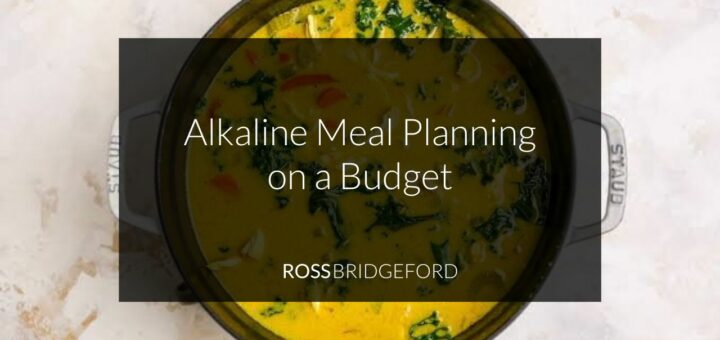Alkaline Meal Planning on a Budget: Saving Money and Reducing Waste
Alkaline Meal Planning: How to Make it Happen
Are you struggling to stick to the alkaline diet? Are you looking for a way to make the diet more affordable, less stressful, and with less food waste? If so, my brand-new guide on Alkaline Meal Planning today is going to be a big help.
If you’ve been following me for any length of time (and I was contacted by a subscriber the other day who has been with me for practically the whole 20 years so far!), you will know I am all about making it easy, making it simple, and making it delicious.
Ultimately, it has to be easy to get started, and simple to stick to…and enjoyable.
And alkaline meal planning is a foundational, fundamental way to incorporate the principles of the alkaline life into your daily life. By planning your meals in advance, you make it so much easier to stick to. You remove the overwhelm, take all the decision-making out of it (“should I have something healthy or go for the unhealthy option”) so you always take the right path, and never have to have that ‘what should I make for dinner’ thought again.
Meal planning can also help you save money on groceries by allowing you to buy in bulk and avoid food waste.
The average US family throws out 30-40% of the foods they buy. On average this equates to $1,866 wasted per year for the average US family.
Can you imagine what it is for you? I know our shopping bills for a family of five are easily $300 per week of fresh food, so that would be around $100 a week for us (if we didn’t meal plan) – or $5200 per year.
Think of what else in your ‘healthy life budget’ you could spend that on that would contribute to your vitality?
In this article, we’ll provide a comprehensive guide to alkaline meal planning. We’ll explain what alkaline meal plans are and how they work, and provide tips on how to create a meal plan that is affordable, stress-free, and easy to follow.
By following an alkaline meal plan, you may be able to improve your health and well-being while reducing your stress levels and food waste. Whether you’re new to the alkaline diet or looking for ways to make it more sustainable, this article will provide you with the information and tools you need to get started.
Save Money, Reduce Waste & Get More Energy!
Meal planning can be a great tool for living the alkaline life, and it has many benefits beyond just promoting better health. Here are some of the benefits:
- Saves Money: Meal planning can help you save money on groceries by allowing you to buy in bulk, take advantage of sales, and avoid last-minute purchases. By planning your meals in advance, you can also choose recipes that use similar ingredients, reducing the need for specialty items and helping you stick to a budget.
- Reduces Waste: alkaline meal planning can help reduce food waste by allowing you to plan for leftovers and repurpose ingredients. You can also choose recipes that use up perishable items before they go bad, reducing the amount of food that gets thrown away.
- Promotes Better Health: Meal planning can help you follow an alkaline diet more consistently, which can lead to better health outcomes. By planning your meals in advance, you can ensure that you are getting a variety of alkaline foods and balancing your macronutrients properly.
Here are some tips for meal planning on a budget:
- Set a Budget: Before you start meal planning, set a budget for your groceries. This will help you choose recipes that fit within your budget and avoid overspending. Then use a grocery stores online shopping site to check your budget is being met.
- Choose Easy Recipes: Choose recipes that are easy to prepare and don’t require a lot of specialty ingredients. This will help you save time and money on groceries. I have tons here on this site, or if you want the easy button (and to get done-for-you meal plans so you don’t need to do any hard work at all) you can get my Alkaline Recipe System with over 250+ alkaline recipes here)
- Use Up Leftovers: Choose recipes that use up leftovers or can be repurposed in other meals. This will help you reduce waste and save money. In my meal plans I will factor in having last nights dinner for lunch today. This works especially well with soups, curries, ‘pastas’ and the like.
- Cook in Bulk: Cook in large batches and freeze extra portions for later. This will help you save time and money on groceries and reduce the need for last-minute purchases. This also reduces the risk of the ol’ “there’s nothing to eat, so let’s get some unhealthy takeaway/uber eats”. This is one of the biggest breaking points I see in most people’s health journey – there is nothing healthy to quickly pull together, so you reach for convenience (which is almost always acidic).
Do I Need to Buy Organic?
When it comes to buying alkaline foods, many people wonder whether it’s necessary to buy organic. While organic foods are generally considered to be the best option, they can also be more expensive and harder to find. The good news is that you don’t necessarily need to buy organic to follow an alkaline diet and reap its health benefits. Organic is best, but don’t let it hold you back.
How to decide:
To prioritize which alkaline foods to buy organic, you can consult the Environmental Working Group’s (EWG) Clean Fifteen and Dirty Dozen lists. The Clean Fifteen is a list of produce with the lowest pesticide residue, while the Dirty Dozen is a list of produce with the highest pesticide residue. By choosing to buy organic versions of produce on the Dirty Dozen list, you can reduce your exposure to harmful pesticides. Meanwhile, non-organic versions of produce on the Clean Fifteen list are generally considered safe to eat.
The 2022 Dirty Dozen list includes:
- Strawberries
- Spinach
- Kale, collard, and mustard greens
- Nectarines
- Apples
- Grapes
- Cherries
- Peaches
- Pears
- Bell peppers
- Celery
- Tomatoes
The 2022 Clean Fifteen list includes:
- Avocados
- Sweet corn
- Pineapples
- Onions
- Papayas
- Sweet peas (frozen)
- Eggplants
- Asparagus
- Broccoli
- Cabbage
- Kiwi
- Cauliflower
- Mushrooms
- Honeydew melon
- Cantaloupe
It’s important to note, eating non-organic alkaline foods is still far better than not eating alkaline foods at all. Don’t let perfectionism hold you back. The same goes for water – so many people get bogged down in filters, ionizers, pH drops and the like and end up with paralysis from analysis. Don’t get stuck in overwhelm. Any water is better than being dehydrated. Just get started.
How to Create Your Meal Plan
Alkaline meal planning can seem daunting at first, but with a little bit of planning and preparation, it can be easy and enjoyable. Here are some steps to help you create your alkaline meal plan:
- Set Your Goals: Before you start planning your meals, it’s important to set your goals. Are you looking to lose weight, improve your energy levels, or reduce inflammation? Knowing your goals will help you choose the right foods and portions to include in your meal plan.
- Choose Your Recipes: Choose recipes that include a variety of alkaline foods, including plenty of fruits and vegetables, whole grains, and lean proteins. Look for recipes that are easy to prepare and can be made in large batches to save time and reduce waste.
- Plan Your Meals: Once you have chosen your recipes, start planning your meals for the week. Use a printable or digital meal planning template to help you stay organized and on track. Be sure to include all meals and snacks, and plan for any leftovers or make-ahead meals.
- Make a Shopping List: Once you have planned your meals, create a shopping list of all the ingredients you will need. Check your pantry and fridge for any items you already have on hand, and only buy what you need to avoid overspending and reduce waste.
- Prep Your Meals: To make mealtime easier, consider prepping your meals in advance. This can include chopping vegetables, cooking grains and proteins, and portioning out snacks. By prepping your meals in advance, you can save time and make healthy choices throughout the week.
It’s also important to remember to be flexible with your meal plan. Including a few gaps in your meal plan for cheat meals or allowing yourself to have one of your normal, regular meals in a few spots can help prevent you from feeling overwhelmed and give you a sense of freedom. If you are just starting out with an alkaline diet, including some wiggle room in your meal plan can help you ease into the new routine without feeling too restricted.
By following these steps and including some flexibility, you can easily create an alkaline meal plan that meets your health goals and fits within your budget and lifestyle. Remember to be kind to yourself and make adjustments as needed to ensure that you are getting a variety of foods and nutrients.
Example Alkaline Meal Plan
Below you will see an example alkaline meal plan that is part of The Alkaline Recipe System. I believe the best way to explain how an alkaline meal plan works is to show you what one looks like!
There are a few pointers I want to make clear, as this will make it a lot easier:
- Start on a Saturday: human nature seems to make us want to start everything new on a Monday. A work day. When we’re super-busy. This makes no sense. Start on a weekend when you have lots of time and space to make it work.
- Shop on a Friday: get your shopping done the day before, so you don’t wake up hungry…needing to shop.
- Allow space for leftovers: you’ll see that many times I will include a lunch time that basically says ‘Leftovers’. Making two serves takes the same time as making one serve, so you may as well make two and have the other serve tomorrow.
- Plan in snacks, drinks, and everything else not just the main meal times. Snacks and drinks are two sneaky ways people’s healthy intentions can fall apart. Plan, plan, plan.
- Allow treat meals. I have done this on the Friday in the meal plan below, but if you’re first starting out, you can go easy on yourself and work it so your timetable and meal plan are in sync. For instance, I often include ‘YOUR CHOICE’ at lunchtimes, and breakfasts, in my clients meal plans – and a good starting point for this is Monday lunchtime. Again, you’re back to work, and assuming you can get a healthy lunch on the go is a risk, and packing a packed lunch on a busy Monday morning might be forgotten. So allow a ‘YOUR CHOICE’ on Monday lunchtime. Allow for 5-6 ‘your choices’ throughout the week.
- Feel free to be repetitive. You don’t have to have a different meal at every meal time every day. You can repeat meals you love and find easy.

Remember, living a healthy, alkaline life, with loads of energy and vitality should be EASY AND FUN!
With a little bit of planning and preparation, you can easily create an alkaline meal plan that fits within your budget and lifestyle.
If you’re feeling overwhelmed, don’t forget to be flexible with your meal plan and allow for cheat meals or regular meals to prevent feeling too restricted. And if you’re looking for additional resources and support, consider The Alkaline Recipe System, which includes two recipe books, 28 days of meal plans, and an itemized shopping lists – everything done-for-you, delicious and easy.
With these tips and resources, you can easily create an alkaline meal plan that meets your health goals, fits within your budget, and is enjoyable to follow. Start planning today and enjoy the benefits of an alkaline life for years to come.





